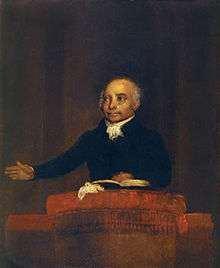Thomas Paul

Thomas Paul (1773–1831) was a Baptist minister in Boston, Massachusetts, affiliated with the African Meeting House and the Education Society for the People of Colour.[2][3] His contributions are more palpable today through his work as an abolitionist, his leadership in the black community, and his support for Haiti. He helped establish a long line of black leaders, many of whom came from his own family. Paul lived in Boston's Beacon Hill neighborhood.[4] His children included activist Susan Paul.[5]
Biographical Data
He was born in Exeter, New Hampshire; the eldest of six brothers, three including Nathaniel Paul, Benjamin Paul became Baptist preachers. His sister Nancy married James Monroe Whitfield.[6][7] Nathaniel was a minister at Albany, NY, and founder of the Providence's United African Society in the 1820s. Benjamin was minister of the Abyssinian Baptist Church in New York. In 1805 he married Catherine Waterhouse and had three children, Ann Catherine, Susan, and Thomas, Jr.[nb 1] Shortly they moved to Boston.[9]
Social Activism and Religious Leadership
Paul was educated for the ministry in Hollis, New Hampshire, at the Free Will Baptist church.[6][10] He was then instrumental in founding the first African Baptist Church in Joy Street, Boston in 1805, and the Abyssinian Baptist Church in New York in 1808.[11] Paul was known for his oratory and organizational skills. Together with other black leaders, he contributed to the development of Black Liberation Theology by tying biblical teachings to social justice and the quest for African American equal acceptance in society.[12] Paul also played a key role in Boston black community as a Prince Hall Mason and opposing integrated education.[13]
Work in Haiti
In 1815, Paul travelled with Prince Saunders to England, in a delegation from the Masonic Lodge of Africans, meeting William Wilberforce and Thomas Clarkson. A topic raised was of black emigration to Haiti.[14] With the support of the white Massachusetts Baptist Society, in May 1823, Paul left for Cap-Haïtien, Haiti as a missionary where to his surprise he discovered other Christian Protestants, but speaking no French made little impact on the Catholic population there.[6] Paul forged relationships with the Haitian President, Jean-Pierre Boyer and his Secretary General, Joseph Balthazar Inginac. In December 1823, Paul returned to Boston giving a favorable report of his work in Haiti.[15]
Notes
- ↑ Thomas Paul Jr. worked as a teacher at the Abiel Smith School.[8]
References
- ↑ http://www.npg.si.edu/cexh/brush/index/portraits/paul.htm Retrieved 05-21-2010
- ↑ Christian Herald v.4, no.15, Jan. 3, 1818.
- ↑ Winchel. Concord Gazette, Jan. 19, 1819.
- ↑ Boston Directory. 1807, 1818, 1823.
- ↑ Lois Brown. Out of the Mouths of Babes: The Abolitionist Campaign of Susan Paul and the Juvenile Choir of Boston. New England Quarterly, Vol. 75, No. 1 (Mar., 2002), pp. 52-79.
- 1 2 3 Nathan Aaseng, African-American Religious Leaders (2003), p. 168–9.
- ↑ Robert Steven Levine, Ivy G. Wilson (editors), The Works of James M. Whitfield: America and other writings by a nineteenth-century African American poet (2011), p. 7; Google Books.
- ↑ Adelaide M. Cromwell (1994), The Other Brahmins: Boston's Black Upper Class, 1750-1950, University of Arkansas Press, OL 1430545M
- ↑ Yee, Shirley. "Paul, Thomas, Sr. (1773-1831)". Blackpast.org. Retrieved May 22, 2014.
- ↑ Smithsonian National Portrait Gallery page.
- ↑ Charles Eric Lincoln, Lawrence H. Mamiya, The Black Church in the African-American Experience (1990), p. 25; Google Books.
- ↑ Hinks, Peter Pringle (1993). "We must and shall be free": David Walker, Evangelicalism, and the Problem of Antebellum Black Resistance. Thesis (Ph. D.)--Yale University. pp. 115–117.
- ↑ Grover, Kathryn; da Silva, Janine V. (December 31, 2002). "Historic Resource Study Boston African American National Historic Site": 5. CiteSeerX 10.1.1.174.1345.
- ↑ Léon Dénius Pamphile, Haitians and African Americans: a heritage of tragedy and hope (2001), p. 38; Google Books.
- ↑ Armstrong, Samuel T. (April 1824). "Hayti". The Missionary Herald. 20 (4): 127.
Further reading
| Wikimedia Commons has media related to Thomas Paul. |
- Horton, James Oliver. "Generations of Protest: Black Families and Social Reform in Ante-Bellum Boston." New England Quarterly, Vol. 49, No. 2 (Jun., 1976): 242–256.
- Kachun, Mitch. "Antebellum African Americans, Public Commemoration, and the Haitian Revolution: a problem of historical mythmaking." Journal of the Early Republic Vol. 26, No. 2 (Summer, 2006):249–273.
- White, Arthur O. "Antebellum School Reform in Boston: Integrationists and Separatists." Phylon Vol. 34, No. 2 (2nd Qtr., 1973): 203–217.